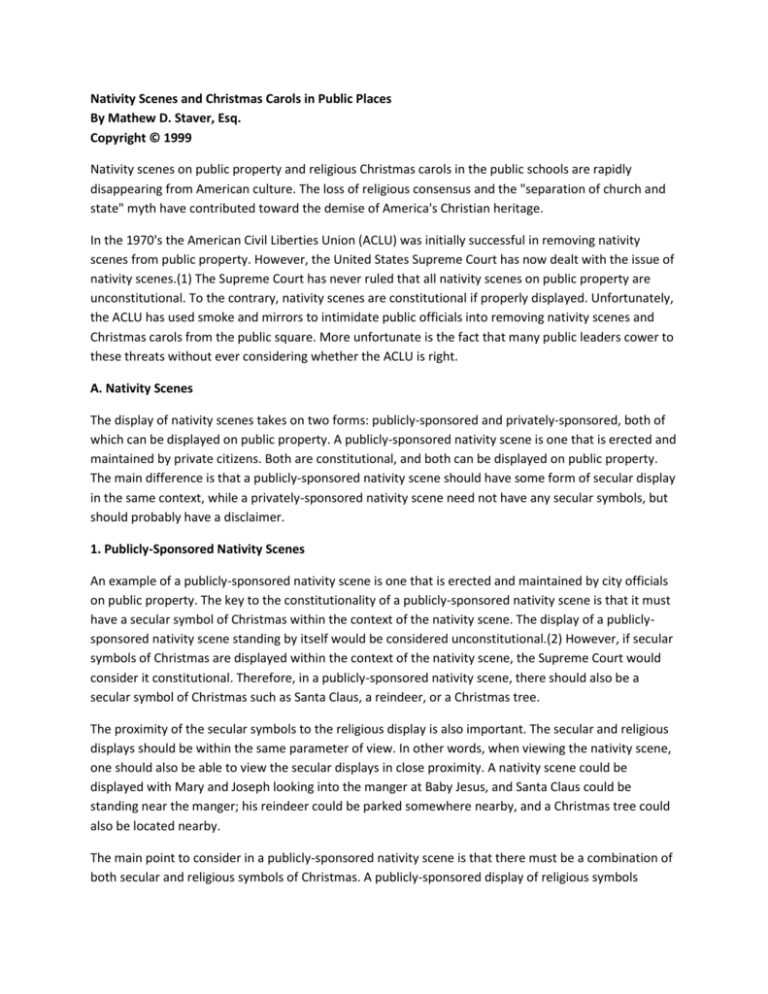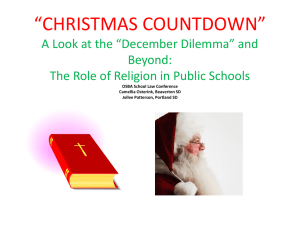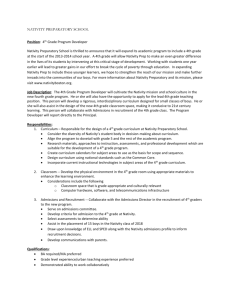Nativity-Scenes-and-Christmas-Carols-in-Public-Places-by
advertisement

Nativity Scenes and Christmas Carols in Public Places By Mathew D. Staver, Esq. Copyright © 1999 Nativity scenes on public property and religious Christmas carols in the public schools are rapidly disappearing from American culture. The loss of religious consensus and the "separation of church and state" myth have contributed toward the demise of America's Christian heritage. In the 1970's the American Civil Liberties Union (ACLU) was initially successful in removing nativity scenes from public property. However, the United States Supreme Court has now dealt with the issue of nativity scenes.(1) The Supreme Court has never ruled that all nativity scenes on public property are unconstitutional. To the contrary, nativity scenes are constitutional if properly displayed. Unfortunately, the ACLU has used smoke and mirrors to intimidate public officials into removing nativity scenes and Christmas carols from the public square. More unfortunate is the fact that many public leaders cower to these threats without ever considering whether the ACLU is right. A. Nativity Scenes The display of nativity scenes takes on two forms: publicly-sponsored and privately-sponsored, both of which can be displayed on public property. A publicly-sponsored nativity scene is one that is erected and maintained by private citizens. Both are constitutional, and both can be displayed on public property. The main difference is that a publicly-sponsored nativity scene should have some form of secular display in the same context, while a privately-sponsored nativity scene need not have any secular symbols, but should probably have a disclaimer. 1. Publicly-Sponsored Nativity Scenes An example of a publicly-sponsored nativity scene is one that is erected and maintained by city officials on public property. The key to the constitutionality of a publicly-sponsored nativity scene is that it must have a secular symbol of Christmas within the context of the nativity scene. The display of a publiclysponsored nativity scene standing by itself would be considered unconstitutional.(2) However, if secular symbols of Christmas are displayed within the context of the nativity scene, the Supreme Court would consider it constitutional. Therefore, in a publicly-sponsored nativity scene, there should also be a secular symbol of Christmas such as Santa Claus, a reindeer, or a Christmas tree. The proximity of the secular symbols to the religious display is also important. The secular and religious displays should be within the same parameter of view. In other words, when viewing the nativity scene, one should also be able to view the secular displays in close proximity. A nativity scene could be displayed with Mary and Joseph looking into the manger at Baby Jesus, and Santa Claus could be standing near the manger; his reindeer could be parked somewhere nearby, and a Christmas tree could also be located nearby. The main point to consider in a publicly-sponsored nativity scene is that there must be a combination of both secular and religious symbols of Christmas. A publicly-sponsored display of religious symbols standing alone is unconstitutional. According to the United States Supreme Court, adding secular symbols to a publicly-sponsored religious display magically makes the display constitutional. 2. Privately-Sponsored Nativity Scenes A privately-sponsored nativity scene can also be displayed on public property, with the main difference being that the display is erected and maintained by private citizens instead of public officials. Privatelysponsored nativity scenes are more common in public parks where citizens are allowed to engage in expressive activity.(3) In most public parks, citizens are allowed to hold gatherings and erect displays. To prohibit religious expression in a public park where other expressive activity is permitted violates the Constitution. Public officials cannot show hostility toward religion by allowing secular expression but prohibiting religious expression. In a privately-sponsored nativity scene, there is no need for secular symbols of Christmas to be displayed within the same context of the religious symbols. A privately-sponsored nativity scene can stand alone, with no display of Santa Claus, a reindeer, a Christmas tree, or other secular symbols. However, in order to clearly designate that the display is privately-sponsored, a disclaimer should be erected, similar to the following example: "This display is privately-sponsored by ABC. The City of XYZ does not endorse nor oppose the display."(4) B. Christmas Carols Christmas carols in public schools should be considered similar to publicly-sponsored nativity scenes. Religious Christmas carols are permissible in the public schools as long as secular songs of Christmas are sung within the same context.(5) For example, a school chorus can sing "Silent Night, Holy Night," if within the same setting the chorus also sings secular songs, such as "Rudolph, the Red-Nosed Reindeer." There is no requirement that a secular song immediately follow a religious song, nor is there a requirement that the songs be divided equally. There should probably be some balance between the secular and religious songs. The main point is that secular Christmas songs should be interspersed throughout the presentation. When faced with a situation where a teacher refuses to permit the singing of religious Christmas songs during a Christmas pageant or chorus, parents and students may insist that religious Christmas songs be sung. The celebration of Christmas clearly has secular and religious aspects. To celebrate only the secular aspects while excluding the religious aspects is outright hostility toward religion. This form of bigotry and religious hostility need not be tolerated. Summary Publicly-sponsored nativity scenes are constitutional so long as within the context of the religious display there are also secular symbols of Christmas. Privately-sponsored nativity scenes are also constitutional. There is no requirement that secular symbols be within the same context of the display, but a disclaimer should be posted indicating that the display is privately-sponsored. Religious Christmas songs may be sung in public schools so long as secular Christmas songs are interspersed throughout the presentation. Unfortunately some public officials mistakenly believe that censoring religion from the public square is the safest approach. City officials have removed nativity scenes under the mistaken belief that the display of religious symbols is unconstitutional. School principals have prohibited the singing of religious carols under the same misguided belief. However, rather than avoiding a constitutional violation by removing religion, these officials actually create a constitutional violation by censoring religion. Indeed, the display of religious symbols on public property and the singing of religious Christmas carols in public schools are protected by the constitutional guarantee to freedom of speech and freedom of religion. Censoring religion violates the core of our constitutional freedoms. Index of Citations (1) Lemon v. Kurtzman, 403 U.S. 602 (1971); County of Allegheny v. American Civil Liberties Union, 492 U.S. 573 (1989). (2) Id. (3) See Capitol Square Review and Advisory Board v. Pinette, 115 S. Ct. 2440 (1995); Doe v. Small, 964 F.2d 611 (7th Cir. 1992) (en banc). (4) A disclaimer on a privately-sponsored nativity scene on public property is not necessary but may be helpful to alert the public that the display is in fact privately-sponsored. (5) Florey v. Sioux Falls School District 49-5, 619 F.2d 1311 (8th Cir.), cert denied, 449 U.S. 987 (1980).







